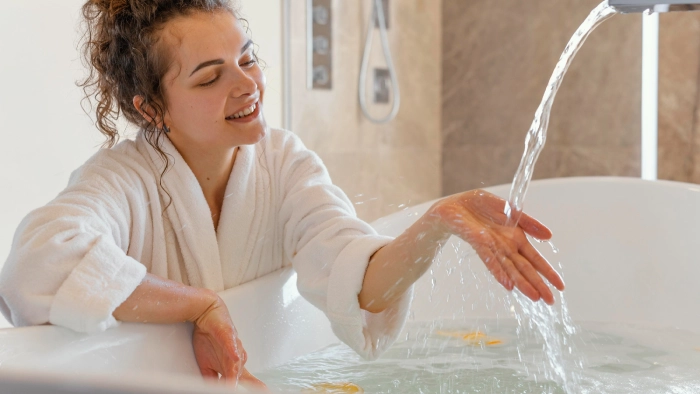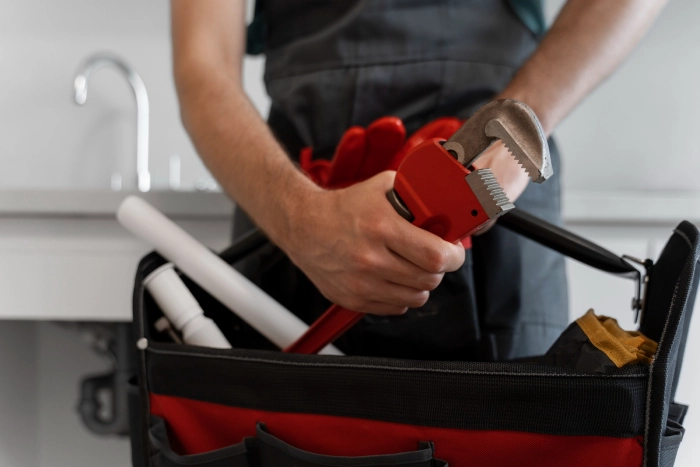
Low water pressure in your bathroom can be a frustrating issue, making simple tasks like showering or washing your hands feel like a chore. Fortunately, many common causes can be addressed with simple solutions. In this guide, we’ll explore common reasons for low water pressure in bathrooms and a step-by-step guide to help you restore strong, consistent water flow.
Causes of Low Water Pressure in the Bathroom
Low water pressure can be caused by various factors. By identifying the root cause of the problem, we can implement targeted solutions to restore optimal water pressure in your bathroom. Here are some common causes of low water pressure in the bathroom:
Mineral Buildup
As time passes, minerals such as calcium and magnesium may build up inside pipes, faucets, and showerheads, restricting water flow. This buildup, often referred to as limescale or scale, can significantly reduce water pressure if left untreated. It’s particularly common in areas with hard water.
Pressure Regulator Problems
Pressure regulators control the flow of water entering your home from the municipal supply and maintain consistent pressure throughout the plumbing system. If the regulator is faulty or improperly adjusted, it can result in insufficient water pressure. A professional plumber can inspect and adjust the pressure regulator or install a new one if necessary to restore proper pressure levels.
Pipe Corrosion
Galvanized steel or iron pipes in older homes are susceptible to corrosion, potentially causing blockages and leaks. Rust and corrosion eat away at the interior of the pipes, restricting water flow and causing pressure loss. Replacing corroded pipes with more durable materials like copper or PEX can improve water pressure and prevent further deterioration.
Leaking Pipes
Even minor leaks in the plumbing system can result in significant water loss and reduced pressure. Common signs of leaks include damp spots, water stains, or mold growth. Locating and repairing leaks promptly is essential to prevent water damage and restore optimal pressure.
Clogged Pipes or Drains
Hair, soap scum, debris, and other substances can accumulate inside pipes and drains, obstructing the flow of water. Drain cleaners, plumbing snakes, or hydro-jetting may be used to clear clogs and restore proper water flow. Consistent maintenance can help prevent clogs from forming, such as using drain guards and periodic cleaning.
Faulty Fixtures
Worn-out or malfunctioning fixtures, such as faucets, showerheads, or valves, can impede water flow and reduce pressure. Inspecting and replacing damaged components, such as worn washers or clogged aerators, can often resolve this issue. Upgrading to high-efficiency fixtures can also improve water pressure while conserving water.
Closed or Partially Closed Valves
Check all shut-off valves near fixtures, supply lines, and the main water line to ensure they are fully open. Partially closed valves can restrict water flow and cause pressure loss. Adjusting these valves to the fully open position can help restore adequate water pressure.
Municipal Water Supply Issues
If low water pressure is widespread in your area, it may be due to issues with the municipal water supply. Contact your local water utility provider to ask about any known problems or scheduled maintenance activities. Temporary disruptions in supply or fluctuations in pressure may occur during peak demand periods or maintenance work.
Elevation or Distance
Homes located at higher elevations or farther from the municipal water source may experience lower water pressure due to gravitational forces or friction loss in the pipes. Installing a booster pump or pressure-boosting system can help increase water pressure in these situations.
Step-by-Step Guide to Fixing Low Water Pressure Issues

Dealing with low water pressure in your home can be frustrating, but with the right approach can lead to effective resolution of the issue. Follow this step-by-step guide to address this problem in your bathroom:
Step 1: Assess the Situation
Begin by determining if the low water pressure is isolated to specific fixtures or affecting the entire bathroom. Test the water pressure from multiple faucets and showerheads to identify any patterns or inconsistencies. Pay attention to whether the issue is consistent across both hot and cold water sources.
Step 2: Check for Obstructions
Inspect faucets, showerheads, and aerators for any mineral buildup or debris that may be obstructing water flow. Remove and clean these components thoroughly to improve water pressure. Use a small brush or toothpick to dislodge any stubborn deposits.
Step 3: Examine Pipes for Leaks
Inspect for any visible leaks in your plumbing system, including under sinks, behind toilets, and along exposed pipes. Keep an eye out for signs of water stains, dampness, or mold growth. Repairing leaks can significantly improve water pressure and prevent further damage to your home’s infrastructure.
Step 4: Test the Pressure Regulator
If your home is equipped with a pressure regulator, ensure that it is functioning correctly. A malfunctioning pressure regulator can lead to low water pressure issues. Use a pressure gauge to measure the water pressure before and after the regulator. If there is a significant difference, it’s recommended to seek the expertise of a professional to examine and fine-tune the regulator accordingly.
Step 5: Verify Valve Positions
Check all shut-off valves near fixtures and supply lines to ensure they are fully open. Partially closed valves can restrict water flow and cause low water pressure. Turn each valve clockwise to guarantee it is in the fully open position. If you encounter any resistance or difficulty, consider contacting a professional plumber to assist with valve adjustments.
Step 6: Consider External Factors
Evaluate any external factors, such as municipal supply issues or the location of your home relative to the water source. Contact your local water utility provider if you require assistance. They can provide information about any known issues or maintenance activities that may be affecting water pressure in your area.
Step 7: Seek Professional Help
If you’ve tried the above steps and are still experiencing low water pressure, it may be time to consider hiring a professional plumber. They have the necessary expertise and specialized tools to perform a comprehensive examination of your plumbing system. If you’re unsure about how to proceed or if the issue seems complex, opting for professional help is the best course of action.
A licensed plumber can accurately identify the problem and recommend suitable solutions to restore optimal water pressure in your bathroom, providing you with peace of mind and ensuring the job is done right.
FAQs
Can low water pressure in the bathroom affect my appliances?
Yes, low water pressure can affect the performance of appliances. Insufficient water flow may result in longer cycle times, poor cleaning results, or even damage to the appliances over time. Addressing this problem can help improve the overall efficiency and lifespan of your appliances.
How much pressure is needed for a bathroom?
The ideal water pressure usually ranges from 40 to 60 pounds per square inch (psi). This level of pressure ensures sufficient water flow for various bathroom fixtures, including faucets, showers, and toilets, to operate effectively. However, it’s essential to note that specific fixtures may have different pressure requirements.
What is the most common cause of low water pressure?
The most common cause of low water pressure in bathrooms is often attributed to mineral buildup within the plumbing system. Dealing with mineral buildup through regular maintenance and cleaning of fixtures can help alleviate these issues in the bathroom.
Conclusion
Addressing low water pressure in your bathroom requires a systematic approach to identify and resolve underlying issues. While understanding the common causes of low water pressure and following a step-by-step guide can be helpful, it’s essential to consider hiring a professional plumber to avoid unnecessary stress and ensure a thorough and effective resolution.
At True Plumbing Solutions, we understand the frustration that comes with low water pressure. Our skilled team of professional plumbers is committed to delivering dependable solutions to address any plumbing issue you may encounter. Call us today.
